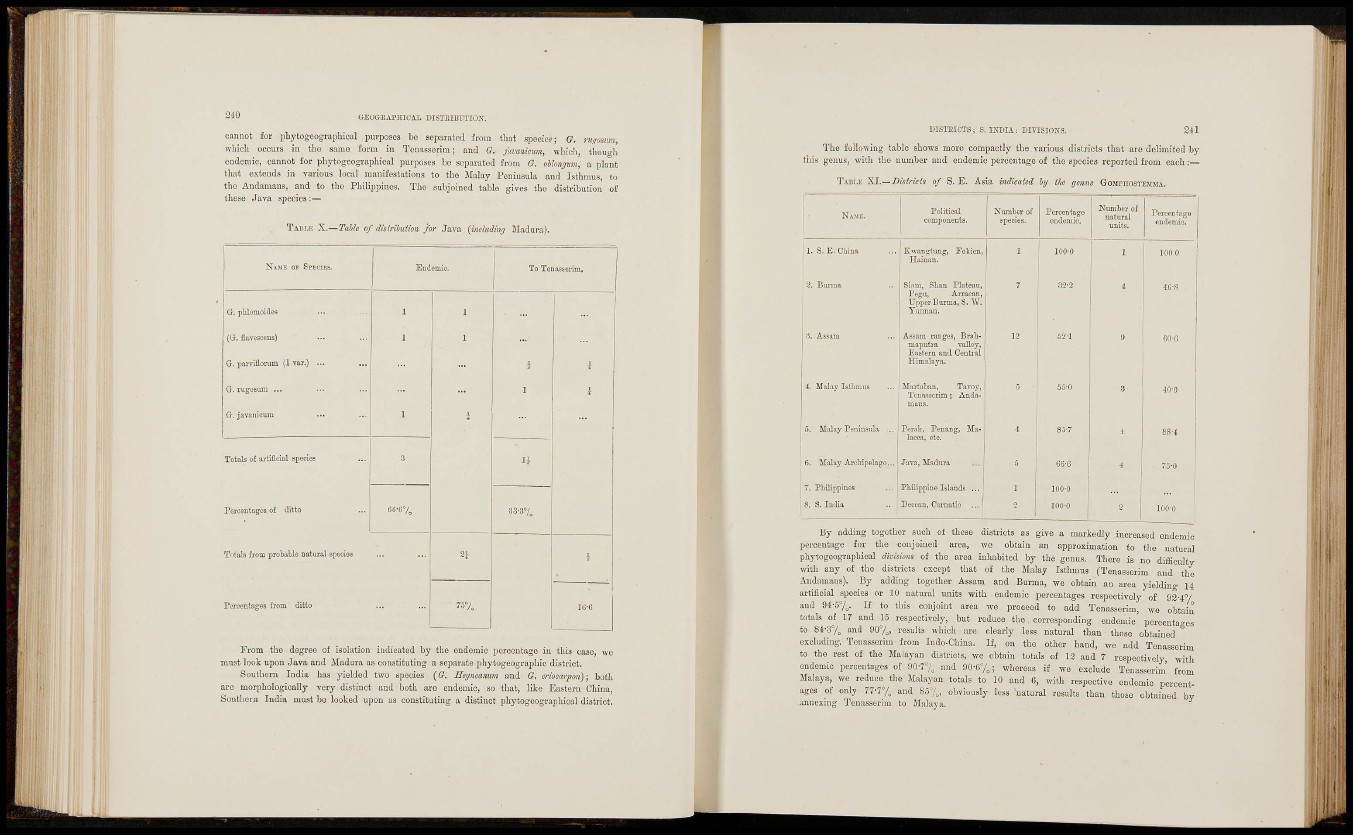
GEOGEAPinCAL DISTEIBUTIOiT.
cannot for phytogeographical purposes be separated from that specicp; G. rugosim,
which occurs in the samo form in Tenasserim; aud G. javanicum, which, though
endemic, cannot for phytogeographical purposes bo separated from G. oUongum, a plant
t h a t extends in various local manifestations to the Malay Peninsula and' Isthmus, to
t h e Andamans, and to the Philippines. The subjoined table gives the distributioa of
these Java species:—
T a b l e 'K.—TaUe of distriluiion / or Java [including Madura).
J l i
Name of SPEABS. Endemic, To Tenasserim.
Gr, pblomoidea 1
(G. flavesceus) 1
G, parviflorum (1 var.) ... i
G. rugosiim ... 1 i
G. javaDicum 1
Totals of artificial species
Percentages of ditto
a U
66-6% 33-3%
Totals from protable natural species
Percentages from ditto
2 i i
7O7O 16-6
F r om the degree of isolation indicated by the endemic percentage in this case, we
must look upon Java and Madura as constituting a separate phytogeographi c district.
S o u t h e r n India has yielded two species ((?. Eeymanum and G. oriocarpon)] botli
a r e morphologically very distinct aud both are endemic, so that, like Eastern China,
S o u t h o r n India must be looked upon as constituting a distinct phytogeographical district.
DISTIIICTS J S. I>-DIA: DIVISIO^'•S.
T h e following table shows more compactly the various districts that are delimited by
t h i s genus, with the number and endemic percentage of the species rejjorted f rom each:
T a b l e Districis of S. E. Asia indicated hj the genus GoMPnosTEMJiA.
i Name. Political
components.
Number of
species.
Pei-centage
eudemio.
Number of
natural
units.
Percentage
endemic.
1. S. E. Cbina
i
Kwangtung, Fokicn,
Hainan.
1 1 1000 1 100 0 :
2. Burma Sjnra, Shan Plateau,
Pegu, Arracnn,
Upper Burma, S. W.
Xunnan.
7 32-2 4 ili'S
Assam Assam ranges, Brahmaputra
valley,
Eastern and Central
Uimalayft.
12 52-1 9 60-6
4. Malay Istbmns Martaban, Tavcy,
Tenasserim; Anda-
0 55'0 3 40'0
5. Malay Peninsula ... Perak, Penang, Malacca,
etc.
• i 857 4 88-4
6. Malay Arciipelajo... Java, Madura 6 66-6 4 7.5-0
7. Pbilippines .,, ; PHlippiue Islands ... 1 lOO-O
i
1 8. S. India .. 1 Decean, Carnatic .., | 2 1000 2 100-0
By adding together such of these districts as give a markedly increased endemic
percentage for the conjoined area, we obtain an approximation to the natural
phytogeographical divisions of the area inhabited by the genus. There is no difficulty
w i t h any of the districts except that of the Malay Isthmus (Tenasserim and the
Andamans). By adding together Assam and Burma, we obtain an area yielding 14
artificial species or 10 natural units with endemic percentages respectively of 92-47
a n d 94-5%. If to this conjoint area we proceed to add Tenasserim, we obtain
t o t a l s of 17 and 15 respectively, but reduce the, corresponding endemic percentacros
t o 84-3% and 90% results which are clearly less natural than those obtained °
excluding, Tenasserim from Indo-China. If, on the other hand, we add Tenasserim
t o the rest of the Malayan districts, we obtain totals of 12 aud 7 respectively with
endemic percentages of 90-7% and 90-6%; whereas if we exclude Tenasserim' from
Malaya, •• '•< ^ •
' a , we reduce the Malayan totals to 10 and 6, with respective endemic pei-centof
ages
onjy 77-7% and 85=/^, obviously less natural results than those obtained by
i i n n e x i n g Tenasserim to Malaya.